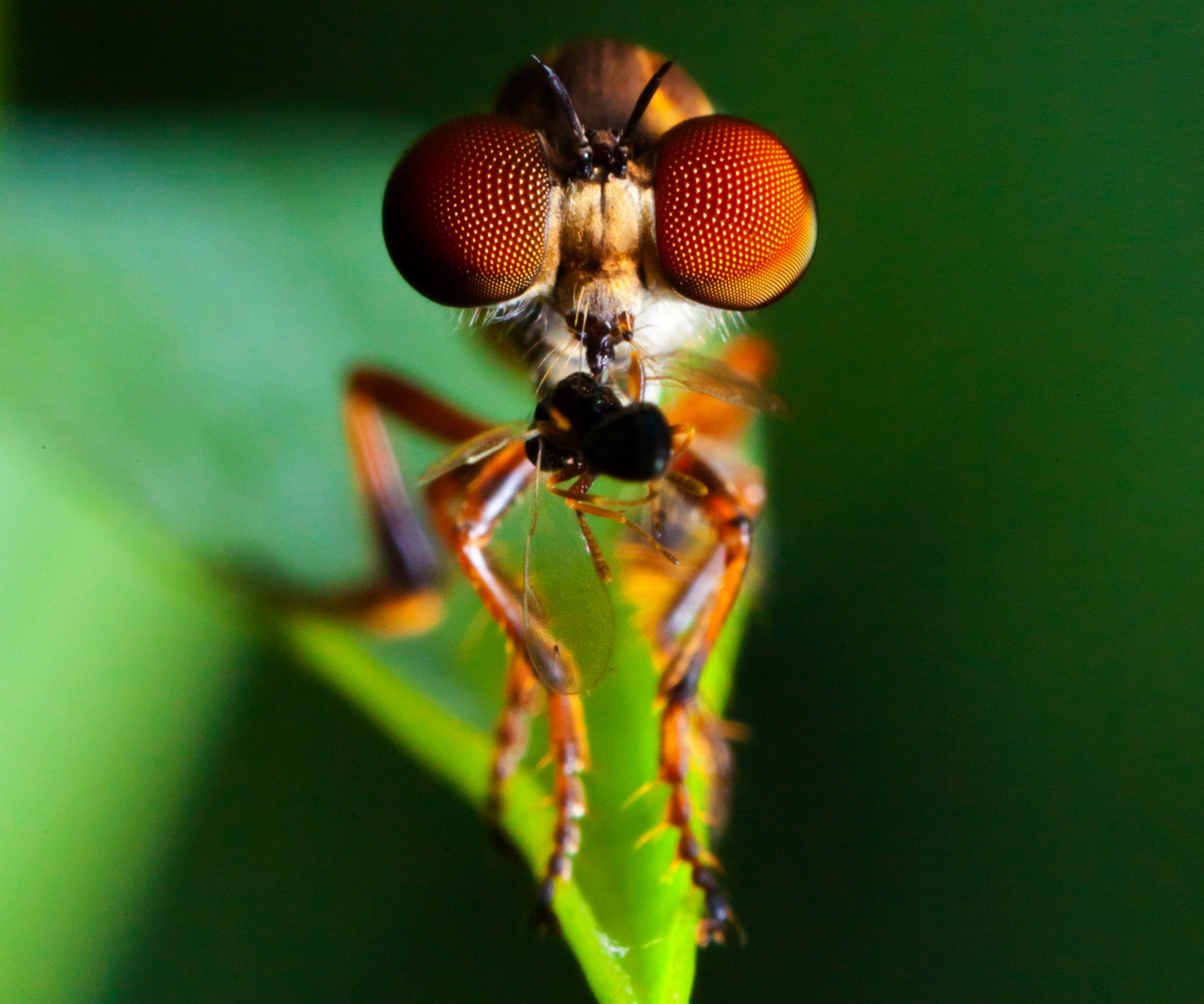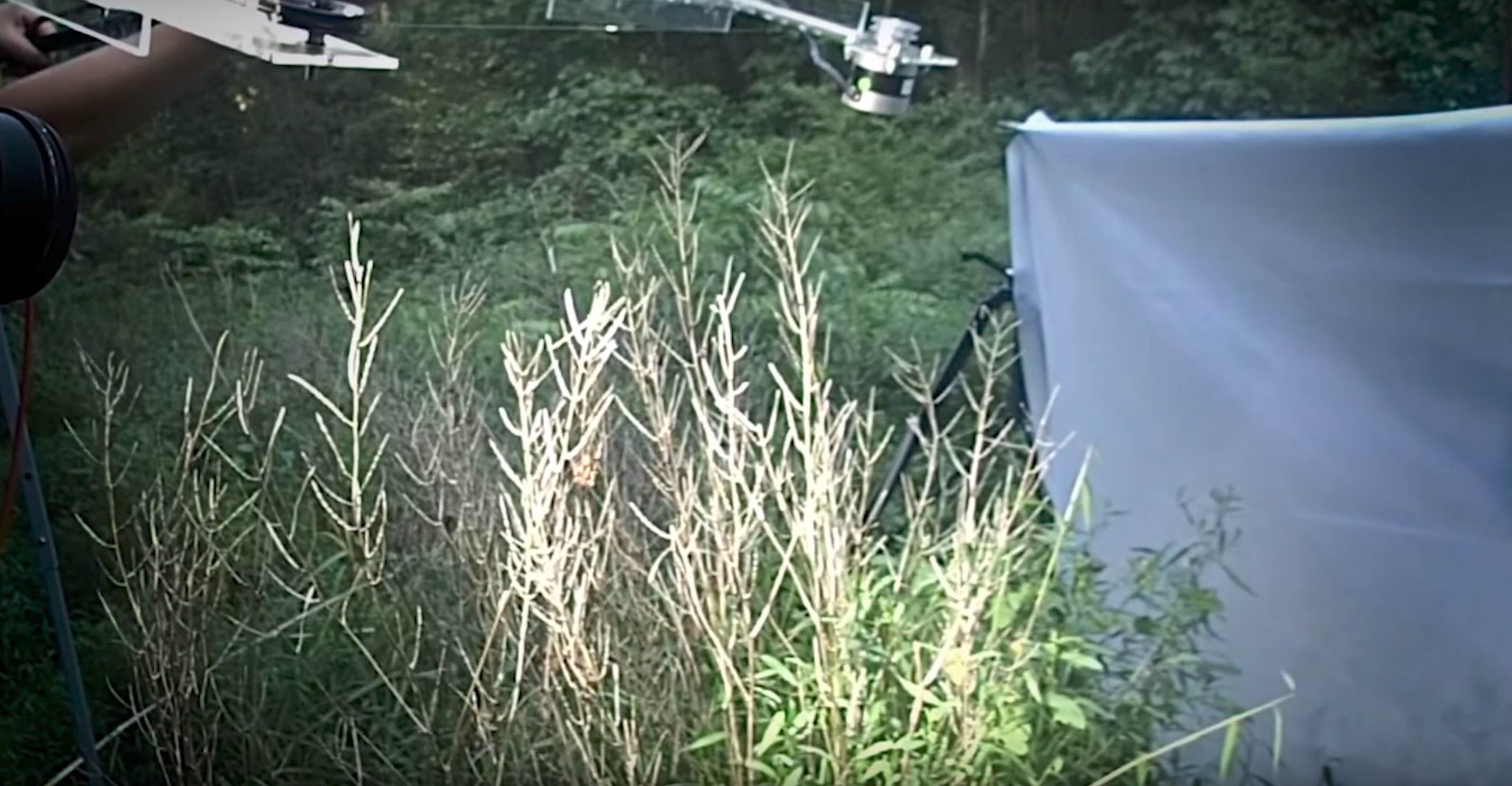This tiny fly is teaching the Air Force new aerial tactics
The robber fly's novel hunting tactics and visual processing capabilities could be applied to drones and airplanes
PhD student Sam Fabian is spending another hot summer's day standing in a field in York, Pennsylvania, surrounded by high-speed camera equipment. Insects buzz around and crawl over Fabian, but he only has eyes for one of them: the tiny robber fly, which is roughly the size of a grain of rice.
Eyes are what brought Fabian out to the scorching field in the first place. Most of the time when it comes to insect eyes, bigger is better. Larger eyes mean more visual sensors, which means better eyesight and better hunting ability. But Holcocephala fusca, the tiny robber fly, is an exception. Despite being just six millimeters in length, it's a highly successful predator in the sky, capable of launching stunning aerial attacks at distances that rival insects ten times its size.

The tiny robber fly is roughly the size of a grain of rice.
Photo by Sam Fabian
Fabian's adviser at the University of Cambridge in the UK, Paloma T Gonzalez-Bellido, was the one who noticed the particularly striking eyes of the robber fly and wanted to know how this influenced the fly's hunting abilities. Her lab published their study on the robber fly in the journal Current Biology in March.
The team's work suggests that the fly's novel eye design and flight tactics might be used to human advantage. Gonzalez-Bellido's not the only one interested in the answer to that question. Her lab's work is partly funded by the U.S. Air Force, which hopes to learn new tactics and flight mechanics from the fly that it can apply to fighter jets and drones.
Back in the field, Fabian waits patiently with his equipment primed and ready, aiming to capture the rapid aerial attack of the tiny predator. Fabian spots a tiny creature on the edge of a blade of grass. A second later, the fly is gone and Fabian hopes the camera has captured the movement that he missed in the blink of an eye.
Binocular vision
Gonzalez-Bellido's team started by dissecting robber flies and examining their visual systems. What they found was an extreme tradeoff: the flies have extremely poor vision in the majority of the eye, but make up for it with a few core souped-up visual sensors. Using these super-sensors, robber flies can see nearly as well as insects that are ten times as large.
“Robber flies see as well as dragonflies, but only over a very narrow field of view, a bit like using binoculars with a high power but restricted field of view,” said Gonzalez-Bellido during an interview, holding her hands up to her eyes in demonstration.
Lots of insects enlarge certain visual sensors, but the robber fly's adaptation is a particularly extreme example. Gonzalez-Bellido wanted to find out how this adaptation related to the fly's hunting abilities, which is why she flew Fabian out to America to study robber flies in their natural environment.
Gone fishing
At first glance, Fabian's field setup seems snazzy. To capture the fly's aerial acrobatics, he used a high-resolution camera capable of capturing 1000 images per second pointed at a white-screen backdrop. Then there was the “fly-teaser,” a mechanized fishing rod that jerked a dummy prey the size of a marble around at random to attract the attention of a robber fly.

Fabian's fishing rod and backdrop setup for luring and documenting flies.
Still image by University of Cambridge via YouTube
But according to Fabian, the setup wasn't exactly like being on a Hollywood film set. “An occasional storm would blow through and knock all the equipment off its perches or you would have days where the flies weren’t anywhere to be found. And robber flies weren’t the only insects about, wasps would chase the robber flies off while we were trying to film them,” he explained.
With the help of local knowledge supplied by park rangers, Fabian was able to find the best spots for his filming and the robber flies soon indulged him. Each fly attack took an average of 800 milliseconds, just enough time to blink twice. But on a camera capturing 1000 images per second, that provided 800 high-resolution freeze frames per run, which could be turned into incredible slow-motion video.
Aerial relay
Despite the ‘on-set’ challenges, filming the flies in action was perhaps the easiest part of the study. The team had to pull in Doekele G. Stavenga from the computational physics department of the University of Groningen, Netherlands to help calculate flight trajectories using algorithms that assessed speed and angle of interception. From these calculations, Fabian, Gonzalez-Bellido and lead co-author Trevor Wardill slowly assembled a picture of robber fly flight tactics.
Launching from its perch, the robber fly tracks its prey similarly to how we might track a ball moving through the sky. There's actually a geometrical model that describes this type of interception. It's known as the constant bearing angle model, and describes how creatures use angles to calculate, or in some cases avoid, a collision course.

A 1,000 frame-per-second slow-motion video of a robber fly on its attack run.
Animated GIF by University of Cambridge via YouTube.
But in the latter part of its attack run, the robber fly suddenly deviates from this model. As it closes in on its prey it, it appears to switch tactics, reducing its speed to match that of its prey rather than continuing on its full speed collision course. Study co-author, Dr. Trevor Wardill, explained that this is a bit like the baton pass in a relay race, where runners change from running as fast as possible to a slower pace that maximizes the chances of a successful transfer. The robber fly appears to use the same slowing tactic to increase its chances of a successful aerial capture.
This is the first time that this “lock-on” phase has ever been described. But even more interesting than the tactic itself is what it might indicate. Because the fly slows down only when it closes in on its prey, Gonzalez-Bellido and her team describe it as a proactive strategy. But does this mean that the fly is actively making tactical decisions in mid-flight?
Decisions, decisions
It's not yet clear whether the robber fly's ability to change tactics is instinctive or requires a higher level of neural processing. If flies are indeed making decisions, it opens up a host of other questions, like: Do they have the ability to plan ahead? Just how clever is a fly? This is a controversial topic for the field, and scientists will need to provide much stronger evidence to change the conventional view that flies simply react to their surroundings.
The Cambridge scientists are now trying to unravel what clues the flies respond to when they change tactics. The most obvious one, given the way the fly slows down, seems to be distance to prey. The researchers are looking again at robber flies’ amazing eyes to explore how they perceive depth.
Lessons from nature
The team also wants to understand more about how the speedsters' tiny brains manage such impressive neural processing. The next questions they want to ask include: How has the robbery fly neural network adapted to efficiently focus their binocular-like visual sensors? How do they launch such swift, precise and successful predation while expending so little energy?
Answers to these questions have the potential to yield useful new technologies. For instance, drones drain batteries swiftly because of the high energy requirements of their visual processing systems. If researchers can learn from the low-energy image processing of the robber fly, power requirements could be minimized and drones' battery life extended.
In a video about the project, Gonzalez-Bellidio explained that “the idea at the moment is that it will be useful for drones to take down illegal drones. Say for example in a concert or in an airport.”
Catching rogue drones? Not bad for a study that started by fishing for robber flies in a field.
Featured article
- Wardill TJ, Fabian ST, Pettigrew AC, Stavenga DG, Nordström K, Gonzalez-Bellido PT. A Novel Interception Strategy in a Miniature Robber Fly with Extreme Visual Acuity. Current Biology. 2017;27(6):854–859. https://doi.org/10.1016/j.cub.2017.01.050.